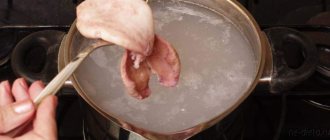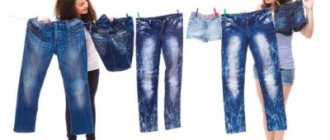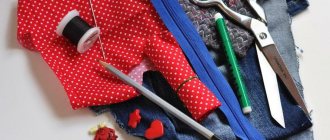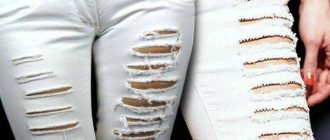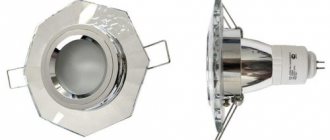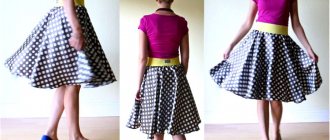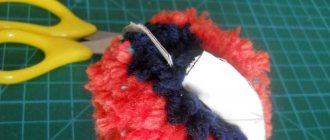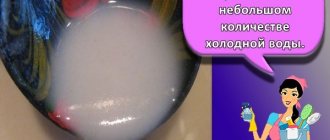Denim items – to iron or not
Denim is a thick fabric used for sewing denim pants, jackets, and dresses. Due to its structure, in most cases it does not need ironing. This is especially true for tight-fitting items, for example, women's tapered pants. Does not need ironing, stretch, it stretches well and evens out on the body itself.
If necessary, items made from denim can be ironed. If there is no such desire, you must follow simple rules for washing and drying jeans:
- Before loading a denim item into the washing machine, you need to turn the fabric inside out and straighten it out;
- wash using laundry soap or powder, without bleach;
- It is mandatory to add air conditioning;
- for an automatic machine, water temperature up to 40 degrees, and spin speed no more than 400 revolutions;
- When you take out your jeans after washing, you need to straighten out the creases;
- dry on a hanger or horizontal surface;
- Do not hang in the scorching sun.
If all recommendations are followed, denim items do not need ironing.
How to properly iron men's and women's jeans after washing
Ironing jeans is used to smooth out creases and soften the fabric. Before carrying out this procedure, you should familiarize yourself with certain recommendations:
- Before you start the process, you need to know whether you can iron wet jeans. Ironing should begin when the jeans are slightly damp. If your pants are completely dry, you need to moisten them with a spray bottle.
- Gauze must be placed on top of the fabric. This will help avoid shiny iron marks.
- To avoid fingerprints on the pockets, you need to put handkerchiefs inside.
- When finished, let the items cool and dry.
Attention! There is no need to iron creases on denim pants. There are no significant differences in ironing women's and men's jeans.
At what temperature should you iron jeans?
The appearance of jeans depends on the ironing temperature. If the temperature is too low, the pants will remain wrinkled, and if the temperature is too high, they may become damaged. Before starting this procedure, you need to study the label. It should indicate the temperature conditions for washing and ironing. Manufacturers generally recommend setting the iron to 150 - 200 degrees.
If there is no tag, then the ironing temperature is set independently. Having set a certain degree, you need to test the iron on the wrong side of the product. If it does not stick to the fabric, then you can start ironing.
Not only the heating temperature matters, but also the ironing mode. It is recommended to set the steam setting, so the fabric will be more pliable and smooth out faster.
"Torn" models
Specially “ripped” jeans are becoming more and more popular. There are a huge number of models with different options regarding the number and size of holes. Holes on the thighs, knees or even buttocks.
To preserve the appearance as much as possible and remain stylish, it is important to adhere to certain rules during ironing and care in general.
Basic Rules:
- It’s worth noting right away that it’s best not to wash these pants in a washing machine, or if washing is unavoidable, then set them to the most delicate mode. The problem is that the machine can turn such fashionable jeans into a torn piece of denim.
- You also need to try to fold the pants so that the torn fabric is inside, and put the clothes themselves in a fabric bag and then put them in the drum of the machine.
- Once the washing is finished, you need to straighten your clothes and hang them to dry.
- You need to iron these pants as carefully as possible. You should start with even areas of fabric and seams.
- During the process, you must constantly apply a damp piece of gauze.
- Ironing must be done on an ironing board so as not to leave marks on the back of the pants from holes in the front.
- To make the process easier, you need to pull the trouser leg onto a special retractable part of the board. It is best not to iron protruding threads from holes.
- To straighten the fibers, just sprinkle them with water, hang them upright and let them dry.
Features depending on the density of denim fabric
The fabric from which jeans are made comes in several types, depending on the density. This factor is also taken into account before ironing. There are the following types of denim:
- Thick fabric. Without impurities, the composition contains only natural cotton. It is ironed at high temperatures, at least 200 degrees. A steam mode is also required.
- Medium weight fabric. Contains additives, softer, prone to creasing. It is necessary to iron at a temperature of about 150 degrees.
- Fabric of the lowest density. This type is very deformed after washing and requires ironing at temperatures up to 110 degrees.
Let's start ironing
First you need to set the correct mode on the iron depending on the fabric. This information is always indicated on a label sewn to the back of the product. But if the tag is lost, use this table.
Table of ironing modes for different fabrics
We start ironing from the top. If necessary, wet the iron, wring it out and iron the waistband, lining, and pockets through it. Do not press the iron too hard so that the seams do not print on the front side of the product. We iron things made of cotton and linen without an iron; this will not damage the fabric.
Iron the entire length of the trouser legs, front and back, bending the seams, iron them at the end with light pressure. Use the steam function.
Iron the trousers through damp gauze or thin fabric
Turn the trousers right side out. Iron as from the inside out, top first. We stretch the trouser legs onto the ironing board or place a pad. We move the iron from place to place, as when steaming, and do not move it without stopping. Iron the trouser legs by turning them on the ironing board around their axis, or turning them over on the table.
After ironing, allow the trousers to “rest” a little so that the moisture evaporates and they cool down. If you put it on right away, the trousers will quickly wrinkle.
Trousers should not have wrinkles even in old age
Advice! Iron synthetic trousers with a warm iron and, if possible, rarely. You only need to moisten individual creases or bruises with a damp cloth, but not the entire fabric. Hold leather trousers over steam and they will straighten out. You can iron them only from the inside out through a damp iron or paper.
Pants with arrows
After you have ironed the pants from the inside out, turned them inside out and pressed the top, fold the legs so that the outer and inner seams match.
To do this, grab the pants by the bottom of the legs and line up all four seams. Then line up the seams at the top and place the garment on the ironing surface. Having folded the belt, align all the seams on top, straighten the product.
This type of clothing is most often sewn with darts in the front. They are where the arrows end when cut correctly. In other cases, the front loop will be the reference point. Fold the fabric along these marks and align the right and left legs. At the back, the arrows taper off to the top of the middle seam.
According to experts, the front arrow should end 7 centimeters before the waist.
It is better to start ironing the arrows from the knee area. Place a damp iron on the fabric, place the iron and wait until the fabric is completely dry. Then move the iron further. Moisten the ironing fabric periodically; it should not be dry.
Fold back the top leg and iron the inside of the bottom leg first. To prevent the fabric from moving, lightly moisten it with a spray bottle first. To prevent the seams from “floating away,” you can fasten them together in several places with tailor’s pins.
To finish the crease at the top, fold the top half of the trousers over the center seam and press.
When you're done with one pant leg, iron the other one.
After this, iron the outside of the legs, folding them evenly together.
After ironing, hang the pants on a hanger. Do not put on until cool.
Properly ironed trousers have perfect creases
Important! First, iron the inner surface of the legs, then the outer surface. To make the arrows last longer, before ironing, spray the inside of the fabric with water with the addition of starch or vinegar.
After the arrows have been ironed, rub them inside with soap and go through the iron again. You can also add vinegar to the water to moisten the gauze at the rate of 1 tablespoon per 1 glass of water. This will strengthen the arrows and prevent the fabric from becoming shiny.
To make the arrows last longer, before ironing, sprinkle the inside of the fabric with water with the addition of starch or vinegar. After the arrows have been ironed, rub them inside with soap and go through the iron again. You can also add vinegar to the water to moisten the gauze at the rate of 1 tablespoon per 1 glass of water. This will strengthen the arrows and prevent the fabric from becoming shiny.
How to iron ripped jeans correctly
Ripped jeans are very popular among young people. They require special care. It is important to know that jeans with designer holes can only be washed by hand. This provokes the formation of creases. Therefore, “torn” jeans need ironing.
There are a few simple rules that must be followed. You need to know how to iron jeans with holes. Necessary:
- using wet gauze;
- use of low temperatures;
- smooth surface for ironing.
You also need to remember that places where there are holes must be treated with extreme caution. It is important not to touch the threads with the iron, otherwise they may break.
We recommend:
How to choose the best steam generator for your home
How to iron jeans without an iron
You can straighten denim material without an iron. There are several simple options:
- ironing with a heated object;
- ferry;
- with the help of moisture;
- press:
- hair curlers;
- liquid iron.
How to iron jeans with a heated object
Bends and creases in the fabric are easily smoothed out using high temperatures. The effect on the material can be carried out without an iron. To do this, you can use the following available tools:
- cup;
- pan;
- frying pan
Procedure:
- it is necessary to heat a metal object on an electric stove or over gas;
- carefully apply to the surface of the fabric;
- wait until the hall disappears.
Note! The surface used must be clean.
Using steam to straighten fabric
Steam can also be used to straighten denim. Before carrying out the procedure, you need to know that this process will take a lot of time. The following steps must be followed:
- boil water in a volume of at least two liters;
- pour into a wide container;
- hang your pants over it.
If all the creases do not disappear the first time, the procedure must be repeated.
Note! After this procedure, the pants may be damp. You need to let them dry before putting them on. If you don't do this, your pants may become tight, especially around the knees.
Moisture to remove creases from denim
With the help of moisture it is also possible to bring your favorite item into proper shape. Denim holds its shape well.
For this you need a spray bottle. Sequencing:
- it is necessary to dial the driver;
- Spray her pants well;
- stretch;
- spread on a horizontal surface;
- let dry.
Press instead of iron
It will take at least eight hours to straighten denim using a press. To carry out the procedure, you will need a heavy object, a board, pots of water, books, and weights. The following recommendations must be followed:
- wash jeans;
- dry until semi-moist;
- place on a horizontal surface;
- place a press prepared from improvised means on top;
- Allow the pants to dry completely.
Ironing with hair curlers
Hair curlers can be used to remove small imperfections in denim. Their effect on trousers is carried out in the same way as on hair. It is necessary to heat the tongs and hold them in place of the creases. The procedure is carried out several times in a row until the defect is eliminated.
Liquid iron
To avoid damage to the fabric, this method is used as a last resort. Liquid iron is made by mixing fabric softener and vinegar in a 1:1 ratio. This mixture is poured into a spray bottle and applied to the trousers. This may harm the appearance of the item and leave an unpleasant odor.
Ironing jeans is not a very complicated process, but before you begin, it is better to familiarize yourself with the basic recommendations. This will help make your jeans perfectly straight and maintain their attractive appearance.
Ironing technique
To avoid unevenness, you need to iron your jeans with a warm iron, following certain rules.
- Only wet trousers can be ironed. If the material is very dry, it needs to be moistened with a spray bottle. The liquid is sprayed evenly over the surface of the trousers, especially on areas that are too wrinkled or hard.
- If you don't have a spray bottle, you can iron your jeans through gauze. It needs to be moistened, spread over the surface of the material, then ironed. The “Steam” mode will help you deal with small creases.
- To avoid damaging the facial fibers, ironing should be done on the reverse side. If you start ironing the front side, the fabric will begin to shine and shine.
- Pants must be turned inside out before ironing. You need to start ironing your pants from the seams, setting the temperature to low. Seam threads are usually made of nylon. At high temperatures, nylon can simply melt.
- The normal temperature for ironing denim is in the range of 140–190 degrees. The thickness of the material and its density are of great importance.
- When the seams on each side are well ironed, the trousers need to be straightened and all remaining areas of the fabric should be ironed.
- Sometimes, due to the high density of the fabric, a stencil may remain in the pocket area. To prevent this from happening, you need to put, for example, a handkerchief in your pocket. Usually this action gives results - after ironing there are no traces left in the pocket area.
- Jeans are never creased. They should only be on fabric trousers. Arrows made on jeans are considered an expression of bad taste and disdain for clothing.
- The pants should dry a little after ironing. They are hung on a rope and laid out on any flat surface.
Some people, when they are in a hurry, put on pants that are not yet completely dry. In cases with jeans, this is not necessary. The result may be loss of shape. Such trousers will have unsightly bulges at the knees.
